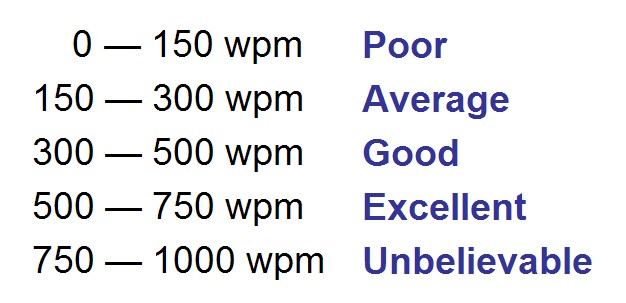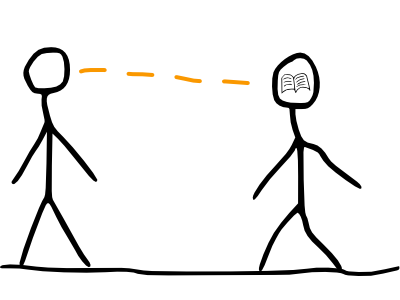Currently aku cuba nak habiskan 3 buah buku untuk cuti 2 minggu ni. Buku yang aku tengah baca sekarang ni :
Kalau ikut kan kepantasan aku baca, memang sure tak sempat nak abeskan ketiga2 buku tu. Dah la aku amek mase 1jam untuk abes 1 chapter. Sangat la slow. Kalau 2 buku sempat kot. Hahaha itu tak termasuk assignment real analysis lagi [kena abeskan 1 chapter dan buat programming latex, adoi boringnya programming nih]
Aku agak teruja dengan seorang readers ni boleh membaca 1200wpm [words per minutes] dan boleh menghabiskan 70 buku dalam setahun. [aku baru jer 200wpm dan cuma berjaya habiskan 5 buku nipis dalam setahun huhu T.T ]
Haa since aku seorang yang pembaca yang perlahan, aku nak share 1 link yang sangat berguna untuk anda sekalian [dan untuk aku gak] . Tips cara nak baca laju2. Ia merupakan tips yang boleh menarik minat anda untuk membaca dengan lebih kerap dan banyak, dengan membaca lebih produktif dan laju. Insya Allah.
----------------------------------------------------------------------------------------------
7 Keys to Reading Faster
Want to read faster?
In this article, I’m going to share the lessons I learned that doubled my reading rate, allowed me to consume over 70 books in a year and made me a smarter reader. I’m also going to destroy some speed-reading myths, to show you it isn’t magic but a skill anyone can learn.
How I Started Speed Reading
My first introduction to the concept of speed reading was from a book, Breakthrough Rapid Reading. I’ve since moved away from a few of the concepts taught in the book, but the core ideas were transformative. In only a few weeks, my average reading speed went from roughly 450 words per minute, to over 900.
More than just words per minute, speed reading helped instill a new passion for reading. Because I gained more control over my reading abilities, my desire to read went up. That new motivation made me a voracious reader, in one two year period, I had read over 150 books.
Here are a few of the lessons I’ve learned from several years of speed reading:
1. Use a Pointer
Your eyes don’t actually stay fixed in one spot. They are frequently making brief twitches away from your center of focus to gather more information. These movements are called saccades and they represent the first tool novice readers can use to read faster.
Normally, when your eye twitches away, it must relocate in its previous position. Unfortunately, when you read, this position is constantly moving. Saccades (and just general distractions) cause you to slow down as you must search for your current reading position. The solution is to use a pointer.
The easiest pointer is just the tip of your finger. Simply place your index finger below a line of text and move it as you read. Initially, using a pointer will be slower than regular reading. But after you’re used to the motion, you can read more effectively.
Note for Advanced Speed-Readers: You can further increase your speed-reading rates by keeping your pointer 1-2cm away from the margins of the text. Your eye can catch the words in about a 1″ radius, so this can shave off a bit of reading time.
2. Speed Reading Is About Control, Not Speed
I dislike the way speed reading is often presented because it makes the skill seem to be only about increasing your top speed. As a result, many people are quick to judge that people can’t physically process more information or point out that comprehension goes down while speed reading.
To me, these arguments miss the point. Speed reading is about controlling your reading rate, not just going faster. If you’re in a racecar, top speed is important, but even more important is the driver’s skill at adjusting speeds to make careful turns. The ability to control your speed will make you a much more efficient reader than just blazing through text.
A pointer helps with control because instead of just using your eyes, you can physically move your hand to adjust your reading speed. If you move your hand faster, you will be forced to read faster. Also, if you slow your pointer down, your reading will slow. This kind of control allows you to carefully read confusing or important sections of text and go faster through obvious text or pieces of fluff.
For example, in a book I’m reading right now, the author frequently resorts to the same 3-4 paragraphs of description to explain a recurring idea. The paragraphs aren’t identical, but similar enough that I can use my pointer to skim through the content and still get the message.
3. Read Without Subvocalizing
When most people first learned to read, they spoke the words aloud. “Jill goes up the hill,” each word being pronounced earnestly by the young student. Eventually, you graduate from speaking aloud because it slows your reading speed. However, most people still vocalize the words inside their head, “Jill goes up the hill,” silently repeated in our minds.
Subvocalization isn’t always a bad thing. It helps us understand and follow a narrative. Just realize it isn’t strictly necessary for comprehension. Jsut as msot poelpe cna urndesnatd tihs secntene, most people don’t need to grasp every single word to get the meaning of a sentence.
Being able to read without subvocalizing is like adding an extra gear to your engine. It can open up the top speed of your reading rate, which is particularly useful for easy to understand or text with a lot of fluff. It isn’t the same as skimming, you’re still moving your pointer across every word.
It’s a method speed readers can use that most normal readers don’t.
Practice moving your pointer faster than you can read words inside your head. This will break you of the habit of automatically subvocalizing.
4. Active Reading
Most people read passively, that is, reading a book hoping the information will strike them across the forehead and declare, “Learn Me!” This is a fine practice when you’re just reading for sheer entertainment, but what if your reading serves a specific purpose?
Speed reading requires active reading. That means, instead of just assuming the information will jump out at you, you become an inquisitive, seeking animal. Before you start reading, prime your mind by asking what you’re hoping to get out of your reading session. Even if you aren’t 100% sure of what you’ll learn, this priming exercise allows your brain to notice relevant details more quickly.
Active reading also means stopping to think about what your reading, as you read it. Stopping to think may not sound like much of a speed reading tactic. It’s not, but it is a smart-reading tactic that everyone should employ. If you find something interesting, pause either to reflect or even note the information in your book.
Would you rather read something today and forget it tomorrow, or read it deeply and make it a part of you?
5. Know When to Slow Down
As I mentioned in key #2, speed reading is about control, not just speed. Many people I’ve talked to after introducing them to speed reading brag about how quickly they dashed through a book. But, these same people later confess that they remember little about what they read.
Just as it is sometimes useful to speed up to move quickly through writing with a low information density, you often need to slow down to catch the important or confusing bits. Let’s view reading as if you are driving a car: If you’re on a straight, well-maintained divided highway, feel free to speed up. But if you’re doing hairpin turns on a dirt road in the mountains, slow down.
More than anything else, speed reading should give you an awareness of your speed. Most people read information with only 2 speeds: skimming and reading. Speed reading is about opening up all the intermediate layers. Now you should be able to skim, read without subvocalizing, read rapidly, read, read slowly and even crawl when faced with confusing or difficult ideas.
6. Make the Material More Interesting
I know, it sounds impossible. How can you possibly make statistics/accounting/Jane Eyre interesting?
But you can make material more interesting if you put some effort in before you pick up the book. No, you can’t make boring topics come alive as if they were the latest thriller fiction. But you can make them interesting enough that you can stay focused while reading.
I know it sounds like something out of a Tony Robbins‘ seminar, but attitude matters. When you’re approaching a book, imagine if you changed your perspective from, “Oh no, here’s some junk I have to read,” to “What could I gain from reading this, if I was really creative about it.” It’s not about confessing a secret love of accounting, it’s about keeping an open mind as to what accounting could teach you.
If you find the material more interesting, you’ll be able to read with complete focus. Complete focus can cut the amount of reading time in a third, without any loss in comprehension. That should be incentive enough to tweak your attitude.
7. Reading Rate Comes With Practice
Although less glamorous than subvocalization or pointer-enabled reading techniques, the best speed reading technique is this: read more to read faster. When you regularly read a book per week, your reading rate will improve.
First, if you aren’t reading in your first language, language proficiency will be your biggest obstacle to high reading rates. I’m an intermediate with French, and my French reading is a crawl compared to my English reading. That’s because every paragraph contains a new word or unfamiliar grammatical construction.
Once again, the way to overcome low proficiency is through practice. Even if you are reading in your first language, some authors will throw big words down you may not understand. My suggestion is that if you encounter such words frequently, look them up. I used Google’s define feature (example, “define simple“) religiously when reading through all of David Foster Wallace’s verbose tome, Infinite Jest.
Second, if you read more frequently, you get a better sense of what speed to go for the type of content and your purposes. NASCAR racers weren’t made that way. They became great at adjusting speeds through practice. Similarly, if you aren’t sure how fast to read a textbook or a novel, those intuitions can be strengthened with practice.
I also suggest for new speed readers to practice reading rather than just read. Practice reading involves taking a fresh book and using the techniques of a pointer and eliminating subvocalization to scroll faster than you can comprehend. This can help train your upper speed-limit reading speeds.
Try It Out!
Want to know your current reading speed? Pick up any book and do the following:
1.Setup a timer for one minute
2.Mark the line you started reading
3.Start reading and stop when the minute is up
4.Mark the line where you stopped
5.Number of lines – Count the number of lines you’ve read
6.Number of words per line – Take the second line and count the number of words in this line (including short words like I, and, etc)
7.Number of lines X Number of words per line = WPM, your words per minute reading speed.
8.Try the above steps with your regular reading pace, and after practicing several tips from above, try the measuring steps again to see how much you’ve improved. Let us know how you did!

-----------------------------------------------------------------------------------------
so, wpm aku lebih kurang 150-200wpm. anda pula??






